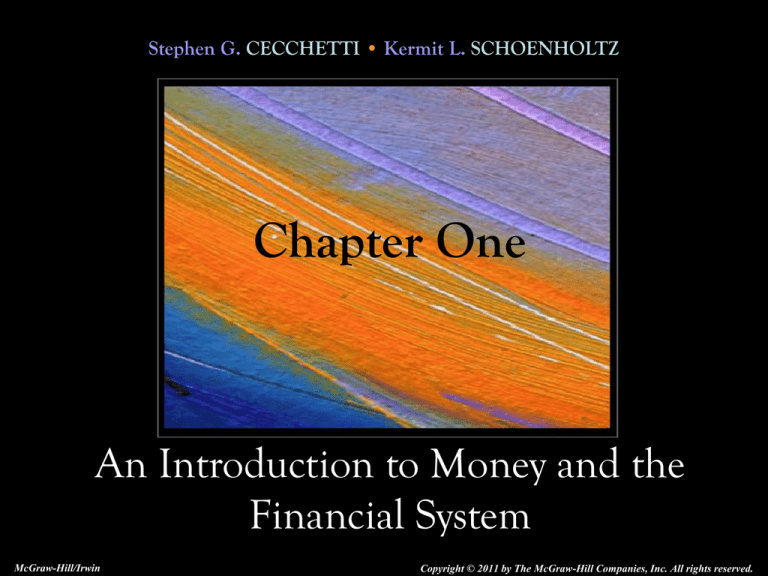
Stephen G. CECCHETTI • Kermit L. SCHOENHOLTZ
Chapter One
An Introduction to Money and the
Financial System
McGraw-Hill/Irwin
Copyright © 2011 by The McGraw-Hill Companies, Inc. All rights reserved.
Introduction
• Every financial transaction has a story.
• There is a complex web of interdependent
institutions and markets making up the
foundation of daily financial transactions.
• The Six Parts of the Financial System.
• The Five Core Principles of Money and
Banking.
1-2
Six Parts of the Financial System
1.
Money
To pay for purchases and store wealth.
2.
Financial Instruments
To transfer resources from savers to investors and to transfer risk to
those best equipped to bear it.
3.
Financial Markets
To buy and sell financial instruments.
4.
Financial Institutions
To provide access to financial markets, collect information &
provide services.
5.
Regulatory Agencies
To provide oversight for financial system.
6.
Central Banks
To monitor financial Institutions and stabilize the economy.
1-3
Six Parts of the Financial System
1. Money
•
•
•
Money has changed from gold/silver coins to
paper currency to electronic funds.
Cash can be obtained from an ATM any where in
the world.
Bills are paid and transactions are checked online.
1-4
Six Parts of the Financial System
2. Financial instruments
•
•
•
Buying and selling individual stocks used to be
only for the wealthy.
Today we have mutual funds and other stocks
available through banks or online.
Putting together a portfolio is open to everyone.
1-5
Six Parts of the Financial System
3. Financial Markets
•
•
•
•
Once financial markets were located in
coffeehouses and taverns.
Then organized markets were created, like the
New York Stock Exchange.
Now transactions are mostly handled by electronic
markets.
• This has reduced the cost of processing
financial transactions.
There is a much broader array of financial
instruments available.
1-6
Six Parts of the Financial System
4. Financial Institutions
•
•
Banks began as vaults, developed into
institutions, to today’s financial supermarket.
Offer a huge assortment of financial products and
services.
1-7
Six Parts of the Financial System
5. Government regulatory agencies
•
•
•
•
Government regulatory agencies were introduced
by federal government after the Great Depression.
Government regulatory agencies provide wideranging financial regulation - rules and
supervision.
Government regulatory agencies examine the
systems a bank uses to manage its risk.
The 2007-2009 financial crises has led
governments to consider greater regulation.
1-8
Six Parts of the Financial System
6. Central banks
•
•
•
Central banks began as large private banks to
finance wars.
Central banks control the availability of money
and credit to ensure low inflation, high growth and
stability of financial system.
Today’s policymakers strive for transparency in
their operations.
1-9
Five Core Principles of
Money and Banking
1.
2.
3.
4.
Time has value.
Risk requires compensation.
Information is the basis for decisions.
Markets determine prices and allocation
resources.
5. Stability improves welfare.
1-10
Five Core Principles of
Money and Banking
A. Core Principle 1: Time has value
• Time affects the value of financial
instruments.
• Interest is paid to compensate the lenders
for the time the borrowers have their
money.
• Chapter 4 develops an understanding of
interest rates and how to use them.
1-11
Five Core Principles of
Money and Banking
B. Core Principle 2: Risk requires
compensation
• In a world of uncertainty, individuals will
accept risk only if they are compensated.
• In the financial world, compensation comes
in the form of explicit payments: the
higher the risk the bigger the payment.
1-12
Five Core Principles of
Money and Banking
C. Core Principle 3: Information is the
basis for decisions
• The more important the decision, the more
information we gather.
• Collection and processing of information is
the foundation of the financial system.
1-13
Five Core Principles of
Money and Banking
D. Core Principle 4: Markets determine
prices and allocate resources.
• Markets are the core of the economic
system.
• Markets channel resources and minimize
the cost of gathering information and
making transactions.
• The better developed the financial markets,
the faster the country will grow.
1-14
Five Core Principles of
Money and Banking
E. Core Principle 5: Stability improves
welfare.
• A stable economy reduces risk and
improves everyone's welfare.
• Financial instability in the autumn of 2008
triggered the worse global downturn since
the Great Depression.
• A stable economy grows faster than an
unstable one.
1-15
• Very few pieces of information are needed to
steal your identity.
• Protect your personal information.
• Never tell your birth date, birthplace, address,
mother’s maiden name.
• Guard your Social Security Number.
• Monitor your financial statements closely.
1-16
Stephen G. CECCHETTI • Kermit L. SCHOENHOLTZ
End of
Chapter One
An Introduction to Money and the
Financial System
McGraw-Hill/Irwin
Copyright © 2011 by The McGraw-Hill Companies, Inc. All rights reserved.








